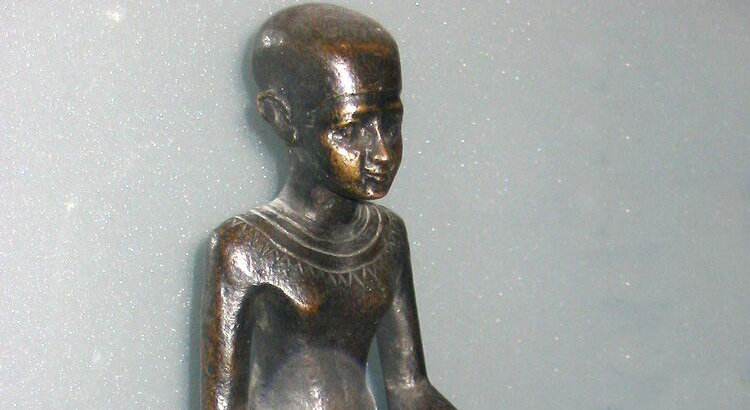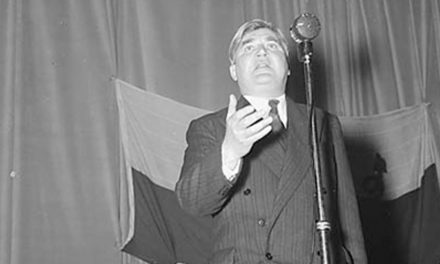The ancient Egyptian civilisation was the first of the recorded great world civilisations. Little is known about the prehistoric societies that came before Egypt but it is assumed that they were steeped in superstition and that their ability to treat disease was primitive at best and possibly non-existent.
The relative stability that Egyptian society provided allowed for advances in science and technology that elevated them far ahead of those that came before. Farming, religion, trade, and travel all flourished and the beginnings of basic hygiene habits, such as toilets and baths, developed. In this burgeoning civilisation, a role for doctors emerged and the Egyptians were the first people to develop a medical profession. The first of these physicians was Imhotep, a man who would go on to become a God.

Statuette of Imhotep in the Louvre, Paris (image courtesy of Hu Totya CC 3.0)
The Age of Djoser
Djoser’s reign as pharaoh marked the start of the third dynasty of ancient Egypt in circa. 2650 BCE. It is not known for certain how long he ruled for but it is estimated to have been somewhere between 19 and 29 years. His reign was marked by great technological innovation and several substantial building projects.
It was during the third dynasty that Imhotep was born. Most sources state that he was born in Ankhtow, a suburb of Memphis, which was the capital at that time. Some sources suggest that he may have been born in the village of Gabelein, south of Ancient Thebes. Roughly translated his name means ‘the one that comes in peace’. Imhotep was born a commoner, possibly the son of an architect called Kanofer, but it quickly became apparent that he was one of the sharpest minds of the time and he rose quickly through the ranks and he went on to became Djoser’s vizier, the highest official to serve the pharaoh. He is considered to have had a genius level intellect and in addition to being Djoser’s vizier, he was an architect, sage, astrologer, and physician.
The First Physician
Sir William Osler described Imhotep as ‘the first figure of a physician to stand out clearly from the mists of antiquity’. His medical practices deviated from the use of magic and prayer that other Egyptian healers used and were remarkably advanced for the time.
Although there are no confirmed writings by Imhotep, the famous Edwin Smith papyrus, named after the dealer who bought it in 1862, is considered by many to have originally been written by him. This ancient text is the oldest known written manual of surgery and trauma and describes 48 cases of wounds, fractures, dislocations, and tumours. Among the treatments described are suturing of wounds, splinting, bandaging, managing infections with honey and resins and the use of raw meat for the purpose of haemostasis. Immobilisation was advised for lower limb fractures and spinal cord injuries and it also describes reasonably detailed anatomical and physiological descriptions.

Plates VI & VII of the Edwin Smith Papyrus from the New York Academy of Medicine
Imhotep is thought to have diagnosed and treated over 200 diseases in his lifetime including tuberculosis, appendicitis, gout, gallstones, and arthritis. He also performed surgery and he may have also founded the first ever school of Medicine in Memphis.
As well as being the first named physician, Imhotep is also the first named architect and was responsible for the most famous building projects of Djoser’s reign, the great stepped pyramid at Saqqara. Djoser himself would eventually be buried there after his death and it is now better known as the pyramid of Djoser.

Imhotep was also a famed architect and built the stepped pyramid of Djoser
The famed American archaeologist and Egyptologist James Henry Breasted said of Imhotep:
“In priestly wisdom, in magic, in the formulation of wise proverbs; in medicine and architecture; this remarkable figure of Djoser’s reign left so notable a reputation that his name was never forgotten. He was the patron spirit of the later scribes, to whom they regularly poured out a libation from the water-jug of their writing outfit before beginning their work.”
The deification of Imhotep
100 years after his death his status was elevated to that of a demigod and around 2000 years after his death in 525 BCE, Imhotep’s status was finally elevated to that of a God of medicine and healing. Together with Amhotep, he was one of only two Egyptian commoners to achieve that status. It is told that people brought offerings in his honour to Saqqara, such as mummified Ibises and clay models of diseased organs and limbs, in the hope of being healed of diseases from which they were suffering.
The story of Imhotep is a truly remarkable one. A commoner by birth that laid the foundations for the medical profession over 4500 years ago and over 2000 years before the birth of Hippocrates. His legacy affected the great civilisations that followed and without him, medicine may not be where it is today.







Thank you for the information Dr. Barton
Thank you for the information Dr. Barton